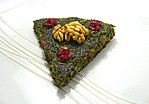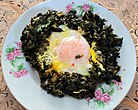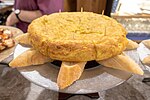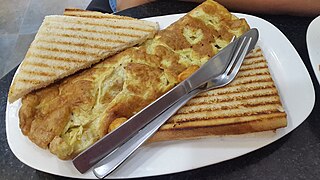
Mexican cuisine consists of the cooking cuisines and traditions of the modern country of Mexico. Its earliest roots lie in Mesoamerican cuisine. Its ingredients and methods begin with the first agricultural communities such as the Olmec and Maya who domesticated maize, created the standard process of nixtamalization, and established their foodways. Successive waves of other Mesoamerican groups brought with them their cooking methods. These included: the Teotihuacanos, Toltec, Huastec, Zapotec, Mixtec, Otomi, Purépecha, Totonac, Mazatec, Mazahua, and Nahua. With the Mexica formation of the multi-ethnic Triple Alliance, culinary foodways became infused.

Turkish cuisine is the cuisine of Turkey and the Turkish diaspora. Although the cuisine took its current rich form after numerous cultural interactions throughout centuries, it should not be confused with other cuisines such as Ottoman cuisine or Seljuk cuisine. Turkish cuisine with traditional Turkic elements such as yogurt, ayran, kaymak, exerts and gains influences to and from Mediterranean, Balkan, Middle Eastern, Central Asian and Eastern European cuisines.
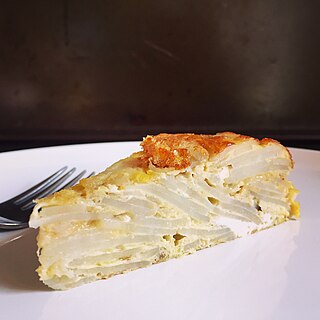
Spanish omelette or Spanish tortilla is a traditional dish from Spain. It is celebrated as one of the most popular dishes of the Spanish cuisine. It is an omelette made with eggs and potatoes, usually including onion. It is often served at room temperature as a tapa.

Fried rice is a dish of cooked rice that has been stir-fried in a wok or a frying pan and is usually mixed with other ingredients such as eggs, vegetables, seafood, or meat. It is often eaten by itself or as an accompaniment to another dish. Fried rice is a popular component of East Asian, Southeast Asian and certain South Asian cuisines, as well as a staple national dish of Indonesia. As a homemade dish, fried rice is typically made with ingredients left over from other dishes, leading to countless variations. Fried rice first developed during the Sui Dynasty in China.
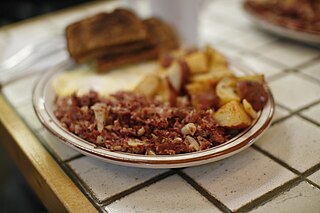
Hash is a dish consisting of chopped meat, potatoes, and fried onions. The name is derived from French: hacher, meaning 'to chop'. It originated as a way to use up leftovers. In the U.S. by the 1860s, a cheap restaurant was called a "hash house" or "hashery."

Torta is a culinary term that can, depending on the cuisine, refer to cakes, pies, flatbreads, sandwiches, or omelettes.

New Mexican cuisine is the cuisine of the Southwestern US state of New Mexico. The region is primarily known for its fusion of Pueblo Native American cuisine with Hispano Spanish and Mexican cuisine originating in Nuevo México. This Southwestern culinary style is popular beyond the current boundaries of New Mexico, and is found throughout the old territories of Nuevo México and the New Mexico Territory, today the state of Arizona, parts of Texas, and the southern portions of Colorado, Utah, and Nevada.

Stuffed peppers is a dish common in many cuisines. It consists of hollowed or halved bell peppers filled with any of a variety of fillings, often including meat, vegetables, cheese, rice, or sauce. The dish is usually assembled by filling the cavities of the peppers and then cooking.

Kuwaiti cuisine is a fusion of Arabian, Iranian, Indian and Mediterranean cuisines. Kuwaiti cuisine is part of the Eastern Arabian cuisine. A prominent dish in Kuwaiti cuisine is machboos, a rice-based dish usually prepared with basmati rice seasoned with spices, and chicken or mutton.

Mexican street food, called antojitos, is prepared by street vendors and at small traditional markets in Mexico. Street foods include tacos, tamales, gorditas, quesadillas, empalmes, tostadas, chalupa, elote, tlayudas, cemita, pambazo, empanada, nachos, chilaquiles, fajita tortas, even hamburgers and hot dogs, as well as fresh fruits, vegetables, beverages and soups such as menudo, pozole and pancita. Most are available in the morning and the evening, as mid-afternoon is the time for the main formal meal of the day. Mexico has one of the most extensive street food cultures in Latin America, and Forbes named Mexico City as one of the foremost cities in the world in which to eat on the street.

Neapolitan cuisine has ancient historical roots that date back to the Greco-Roman period, which was enriched over the centuries by the influence of the different cultures that controlled Naples and its kingdoms, such as that of Aragon and France.

Venetian cuisine, from the city of Venice, Italy, or more widely from the region of Veneto, has a centuries-long history and differs significantly from other cuisines of northern Italy, and of neighbouring Austria and of Slavic countries, despite sharing some commonalities.

Eggah is an egg-based dish in Egyptian cuisine that is similar to a frittata. It is also known as Egyptian omelet. Eggah is commonly seasoned with spices such as pepper, cinnamon, cumin, coriander seeds, turmeric, nutmeg and fresh herbs. It is generally thick, commonly filled with vegetables and sometimes meat and cooked until completely firm. It is usually circle-shaped and served sliced into rectangles or wedges, sometimes hot and sometimes cold. Eggah can be served as an appetizer, main course or side dish.

Kuku or kookoo is an egg-based and often vegetarian Iranian dish made of whipped eggs folded in various ingredients. It is similar to the Italian frittata, the French quiche, or an open-faced omelette, but it typically has less egg than a frittata, and it cooks for a shorter amount of time, over a low heat, before turned over or grilled briefly to set the top layer. It is served either hot or cold as a starter, side dish or a main course, and is accompanied with bread and either yogurt or salad.

Teochew porridge is a Teochew rice porridge dish often accompanied with various small plates of side dishes. Teochew porridge is served as a banquet of meats, fish egg, and vegetables that is eaten with plain rice porridge. It may be simply prepared plain, or include sweet potatoes. The rice grains, while softened from cooking, are still whole and not in an overly starchy state. Because the porridge is served plain, it is suitable to accompany salty side dishes. The recipe originated in Chaozhou and was later modified by early immigrants prepared in Malaysia and Singapore over the generations to suit local tastes.

Tortang talong, also known as eggplant omelette, is an omelette or fritter from Filipino cuisine made by pan-frying grilled whole eggplants dipped in an egg mixture. It is a popular breakfast and lunch meal in the Philippines. A common variant of tortang talong is rellenong talong, which is stuffed with meat, seafood, and/or vegetables.

Okoy or ukoy, are Filipino crispy deep-fried fritters made with glutinous rice batter, unshelled small shrimp, and various vegetables, including calabaza, sweet potato, cassava, mung bean sprouts, scallions and julienned carrots, onions, and green papaya. They are traditionally served with vinegar-based dipping sauces. They are eaten on their own or with white rice. They are popular for breakfast, snacks, or appetizers. Okoy are sometimes dyed bright orange with achuete seeds.







